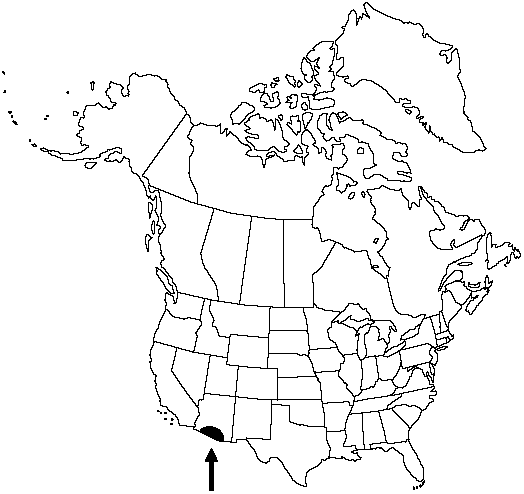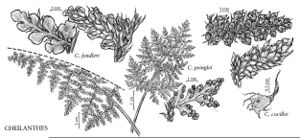Difference between revisions of "Cheilanthes pringlei"
Bull. Torrey Bot. Club 10: 61. 1883.
FNA>Volume Importer |
imported>Volume Importer |
||
| (7 intermediate revisions by 2 users not shown) | |||
| Line 8: | Line 8: | ||
}} | }} | ||
|common_names=Pringle's lip fern | |common_names=Pringle's lip fern | ||
| + | |special_status={{Treatment/ID/Special_status | ||
| + | |code=F | ||
| + | |label=Illustrated | ||
| + | }} | ||
|basionyms= | |basionyms= | ||
|synonyms= | |synonyms= | ||
| Line 17: | Line 21: | ||
}}<!-- | }}<!-- | ||
| − | --><span class="statement" id="st- | + | --><span class="statement" id="st-undefined" data-properties=""><b>Stems </b>long-creeping, 1–3 mm diam.; scales uniformly brown or with poorly defined, dark, central stripe, linear-lanceolate, straight to slightly contorted, loosely appressed, usually persistent. <b>Leaves</b> clustered to somewhat scattered, 4–15 cm; vernation noncircinate. <b>Petiole</b> dark brown, grooved distally on adaxial surface. <b>Blade</b> ovate-deltate, 3-pinnate-pinnatifid at base, 1.5–5 cm wide; rachis grooved adaxially, with scattered, lanceolate scales, not pubescent. <b>Pinnae</b> not articulate, dark color of stalk continuing into pinna base, basal pair conspicuously larger than adjacent pair, inequilateral, basiscopic pinnules enlarged, appearing glabrous adaxially. <b>Costae</b> green adaxially for most of length; abaxial scales multiseriate, lanceolate, truncate or subcordate at base, without overlapping basal lobes, conspicuous, the largest 0.4–0.8 mm wide, loosely imbricate, not concealing ultimate segments, erose, not ciliate. <b>Ultimate</b> segments spatulate, not especially beadlike, the largest usually 2–3 mm, abaxially glabrous or with a few small scales near base, adaxially glabrous. <b>False</b> indusia marginal, weakly differentiated, 0.05–0.25 mm wide. <b>Sori</b> discontinuous, confined to apical or lateral lobes. <b>Sporangia</b> containing 64 spores. <b>2n</b> = 60.</span><!-- |
-->{{Treatment/Body | -->{{Treatment/Body | ||
| + | |phenology=Sporulating late spring–fall. | ||
|habitat=Rocky slopes and ledges, usually on igneous substrates | |habitat=Rocky slopes and ledges, usually on igneous substrates | ||
|elevation=700–1200 m | |elevation=700–1200 m | ||
|distribution=Ariz.;n Mexico. | |distribution=Ariz.;n Mexico. | ||
| − | |discussion=<p>Cheilanthes pringlei is often confused with young, sterile plants of C. fendleri, but it is easily distinguished from the latter by having rachises that are grooved adaxially. This species appears to be restricted to the Sonoran Desert; records from Gila and Cochise counties, Arizona, and southern New Mexico are based on misidentifications.</p> | + | |discussion=<p><i>Cheilanthes pringlei</i> is often confused with young, sterile plants of <i>C. fendleri</i>, but it is easily distinguished from the latter by having rachises that are grooved adaxially. This species appears to be restricted to the Sonoran Desert; records from Gila and Cochise counties, Arizona, and southern New Mexico are based on misidentifications.</p> |
|tables= | |tables= | ||
|references= | |references= | ||
| Line 32: | Line 37: | ||
-->{{#Taxon: | -->{{#Taxon: | ||
name=Cheilanthes pringlei | name=Cheilanthes pringlei | ||
| − | |||
|authority=Davenport | |authority=Davenport | ||
|rank=species | |rank=species | ||
| Line 39: | Line 43: | ||
|basionyms= | |basionyms= | ||
|family=Pteridaceae | |family=Pteridaceae | ||
| + | |phenology=Sporulating late spring–fall. | ||
|habitat=Rocky slopes and ledges, usually on igneous substrates | |habitat=Rocky slopes and ledges, usually on igneous substrates | ||
|elevation=700–1200 m | |elevation=700–1200 m | ||
| Line 45: | Line 50: | ||
|publication title=Bull. Torrey Bot. Club | |publication title=Bull. Torrey Bot. Club | ||
|publication year=1883 | |publication year=1883 | ||
| − | |special status= | + | |special status=Illustrated |
| − | |source xml=https:// | + | |source xml=https://bitbucket.org/aafc-mbb/fna-data-curation/src/2e0870ddd59836b60bcf96646a41e87ea5a5943a/coarse_grained_fna_xml/V2/V2_329.xml |
|genus=Cheilanthes | |genus=Cheilanthes | ||
|species=Cheilanthes pringlei | |species=Cheilanthes pringlei | ||
| − | |||
| − | |||
| − | |||
| − | |||
| − | |||
| − | |||
| − | |||
| − | |||
| − | |||
| − | |||
| − | |||
| − | |||
| − | |||
| − | |||
| − | |||
| − | |||
| − | |||
| − | |||
| − | |||
| − | |||
| − | |||
| − | |||
| − | |||
| − | |||
| − | |||
| − | |||
| − | |||
| − | |||
| − | |||
| − | |||
| − | |||
| − | |||
| − | |||
| − | |||
| − | |||
| − | |||
| − | |||
| − | |||
| − | |||
| − | |||
| − | |||
| − | |||
| − | |||
| − | |||
| − | |||
| − | |||
| − | |||
| − | |||
| − | |||
| − | |||
}}<!-- | }}<!-- | ||
-->[[Category:Treatment]][[Category:Cheilanthes]] | -->[[Category:Treatment]][[Category:Cheilanthes]] | ||
Latest revision as of 20:22, 5 November 2020
Stems long-creeping, 1–3 mm diam.; scales uniformly brown or with poorly defined, dark, central stripe, linear-lanceolate, straight to slightly contorted, loosely appressed, usually persistent. Leaves clustered to somewhat scattered, 4–15 cm; vernation noncircinate. Petiole dark brown, grooved distally on adaxial surface. Blade ovate-deltate, 3-pinnate-pinnatifid at base, 1.5–5 cm wide; rachis grooved adaxially, with scattered, lanceolate scales, not pubescent. Pinnae not articulate, dark color of stalk continuing into pinna base, basal pair conspicuously larger than adjacent pair, inequilateral, basiscopic pinnules enlarged, appearing glabrous adaxially. Costae green adaxially for most of length; abaxial scales multiseriate, lanceolate, truncate or subcordate at base, without overlapping basal lobes, conspicuous, the largest 0.4–0.8 mm wide, loosely imbricate, not concealing ultimate segments, erose, not ciliate. Ultimate segments spatulate, not especially beadlike, the largest usually 2–3 mm, abaxially glabrous or with a few small scales near base, adaxially glabrous. False indusia marginal, weakly differentiated, 0.05–0.25 mm wide. Sori discontinuous, confined to apical or lateral lobes. Sporangia containing 64 spores. 2n = 60.
Phenology: Sporulating late spring–fall.
Habitat: Rocky slopes and ledges, usually on igneous substrates
Elevation: 700–1200 m
Distribution

Ariz., n Mexico.
Discussion
Cheilanthes pringlei is often confused with young, sterile plants of C. fendleri, but it is easily distinguished from the latter by having rachises that are grooved adaxially. This species appears to be restricted to the Sonoran Desert; records from Gila and Cochise counties, Arizona, and southern New Mexico are based on misidentifications.
Selected References
None.
